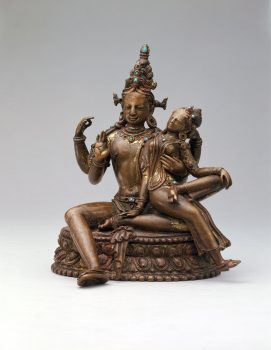Nepal
13th century


Nepal
13th century


The great Hindu god Shiva and his wife Parvati can be considered an exemplar of male-female relationships in the Hindu worldview. Their affection is evident in this sculpture, with Shiva’s hand sliding up Parvati’s torso to caress her breast as she relaxes into him. Parvati sits on Shiva’s thigh, her left hand gently resting on her knee and her right hand positioned on Shiva’s leg. Their grace is emphasized by the long and slender nature of their bodies and limbs, accentuated by Shiva’s high hair knot.This composition exhibits a number of features that are characteristic of Nepalese metal images, including the use of stone insets and the figures’ gentle smiles, as well as details that are found particularly in early Nepalese art, such as the circular lotus base and the pointed ends of the figures’ scarves and clothing, thickened through numerous overlaps. This final feature can be seen here between Shiva’s legs. The figures’ worn foreheads and remnants of vermillion coloring are the result of their use in daily ritual worship.
In Buddhism gender is considered more fluid compared to some other religions. Certain traditions emphasize the importance of all genders in achieving enlightenment. The feminine is considered an embodiment of wisdom and the masculine is an embodiment of method.
A virtuous feeling and deep respect toward an authentic teaching, teacher, or path. Buddhists believe that expansive study, analysis, and meditation are essential steps for cultivating a healthy and enduring devotion.
Hindu gods (deva) are thought to be manifestations of the absolute, or Brahman. The goddesses (devi) are considered manifestations of the Great Mother Goddess (Mahadevi), who is seen as the counterpart to Brahman.
The Himalayan kingdoms of the Kathmandu Valley were significant centers of Buddhist culture. Nepalese kings, Buddhist institutions, and ordinary people patronized the vibrant art guilds. The artistic traditions of the regions are well-known in Tibetan areas and beyond, and Newar artists have always been in high demand throughout Tibetan regions and Inner Asia.
Get the latest news and stories from the Rubin, plus occasional information on how to support our work.